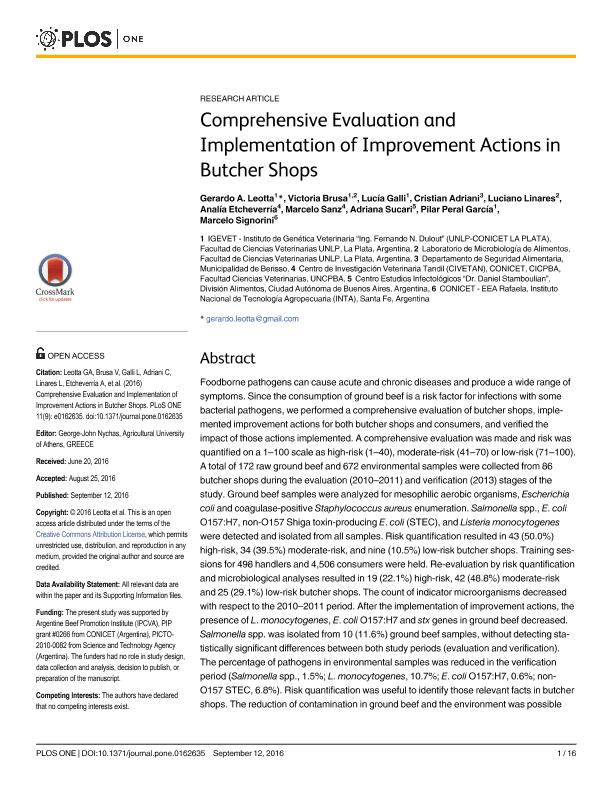Artículo
Comprehensive Evaluation and Implementation of Improvement Actions in Butcher Shops
Leotta, Gerardo Anibal ; Brusa, Victoria
; Brusa, Victoria ; Galli, Lucía
; Galli, Lucía ; Adriani, Cristian; Linares, Luciano Hector; Etcheverría, Analía Inés
; Adriani, Cristian; Linares, Luciano Hector; Etcheverría, Analía Inés ; Sanz, Marcelo Eduardo; Sucari, Adriana; Peral Garcia, Pilar
; Sanz, Marcelo Eduardo; Sucari, Adriana; Peral Garcia, Pilar ; Signorini Porchietto, Marcelo Lisandro
; Signorini Porchietto, Marcelo Lisandro
 ; Brusa, Victoria
; Brusa, Victoria ; Galli, Lucía
; Galli, Lucía ; Adriani, Cristian; Linares, Luciano Hector; Etcheverría, Analía Inés
; Adriani, Cristian; Linares, Luciano Hector; Etcheverría, Analía Inés ; Sanz, Marcelo Eduardo; Sucari, Adriana; Peral Garcia, Pilar
; Sanz, Marcelo Eduardo; Sucari, Adriana; Peral Garcia, Pilar ; Signorini Porchietto, Marcelo Lisandro
; Signorini Porchietto, Marcelo Lisandro
Fecha de publicación:
09/2016
Editorial:
Public Library of Science
Revista:
Plos One
ISSN:
1932-6203
Idioma:
Inglés
Tipo de recurso:
Artículo publicado
Clasificación temática:
Resumen
Foodborne pathogens can cause acute and chronic diseases and produce a wide range of symptoms. Since the consumption of ground beef is a risk factor for infections with some bacterial pathogens, we performed a comprehensive evaluation of butcher shops, implemented improvement actions for both butcher shops and consumers, and verified the impact of those actions implemented. A comprehensive evaluation was made and risk was quantified on a 1–100 scale as high-risk (1–40), moderate-risk (41–70) or low-risk (71–100). A total of 172 raw ground beef and 672 environmental samples were collected from 86 butcher shops during the evaluation (2010–2011) and verification (2013) stages of the study. Ground beef samples were analyzed for mesophilic aerobic organisms, Escherichia coli and coagulase-positive Staphylococcus aureus enumeration. Salmonella spp., E. coli O157:H7, non-O157 Shiga toxin-producing E. coli (STEC), and Listeria monocytogenes were detected and isolated from all samples. Risk quantification resulted in 43 (50.0%) high-risk, 34 (39.5%) moderate-risk, and nine (10.5%) low-risk butcher shops. Training sessions for 498 handlers and 4,506 consumers were held. Re-evaluation by risk quantification and microbiological analyses resulted in 19 (22.1%) high-risk, 42 (48.8%) moderate-risk and 25 (29.1%) low-risk butcher shops. The count of indicator microorganisms decreased with respect to the 2010–2011 period. After the implementation of improvement actions, the presence of L. monocytogenes, E. coli O157:H7 and stx genes in ground beef decreased. Salmonella spp. was isolated from 10 (11.6%) ground beef samples, without detecting statistically significant differences between both study periods (evaluation and verification). The percentage of pathogens in environmental samples was reduced in the verification period (Salmonella spp., 1.5%; L. monocytogenes, 10.7%; E. coli O157:H7, 0.6%; non-O157 STEC, 6.8%). Risk quantification was useful to identify those relevant facts in butcher shops. The reduction of contamination in ground beef and the environment was possible after training handlers based on the problems identified in their own butcher shops. Our results confirm the feasibility of implementing a comprehensive risk management program in butcher shops, and the importance of information campaigns targeting consumers. Further collaborative efforts would be necessary to improve foodstuffs safety at retail level and at home.
Palabras clave:
Stec
,
Salmonella
,
Listeria
,
Butcheries
Archivos asociados
Licencia
Identificadores
Colecciones
Articulos(CIVETAN)
Articulos de CENTRO DE INVESTIGACION VETERINARIA DE TANDIL
Articulos de CENTRO DE INVESTIGACION VETERINARIA DE TANDIL
Articulos(IGEVET)
Articulos de INST.DE GENETICA VET ING FERNANDO NOEL DULOUT
Articulos de INST.DE GENETICA VET ING FERNANDO NOEL DULOUT
Citación
Leotta, Gerardo Anibal; Brusa, Victoria; Galli, Lucía; Adriani, Cristian; Linares, Luciano Hector; et al.; Comprehensive Evaluation and Implementation of Improvement Actions in Butcher Shops; Public Library of Science; Plos One; 11; 9; 9-2016; 1-16; e0162635
Compartir
Altmétricas



